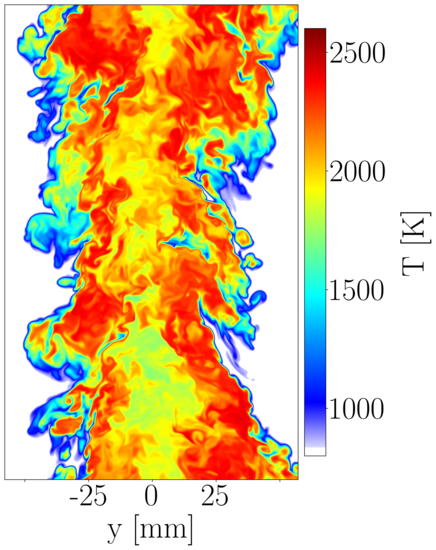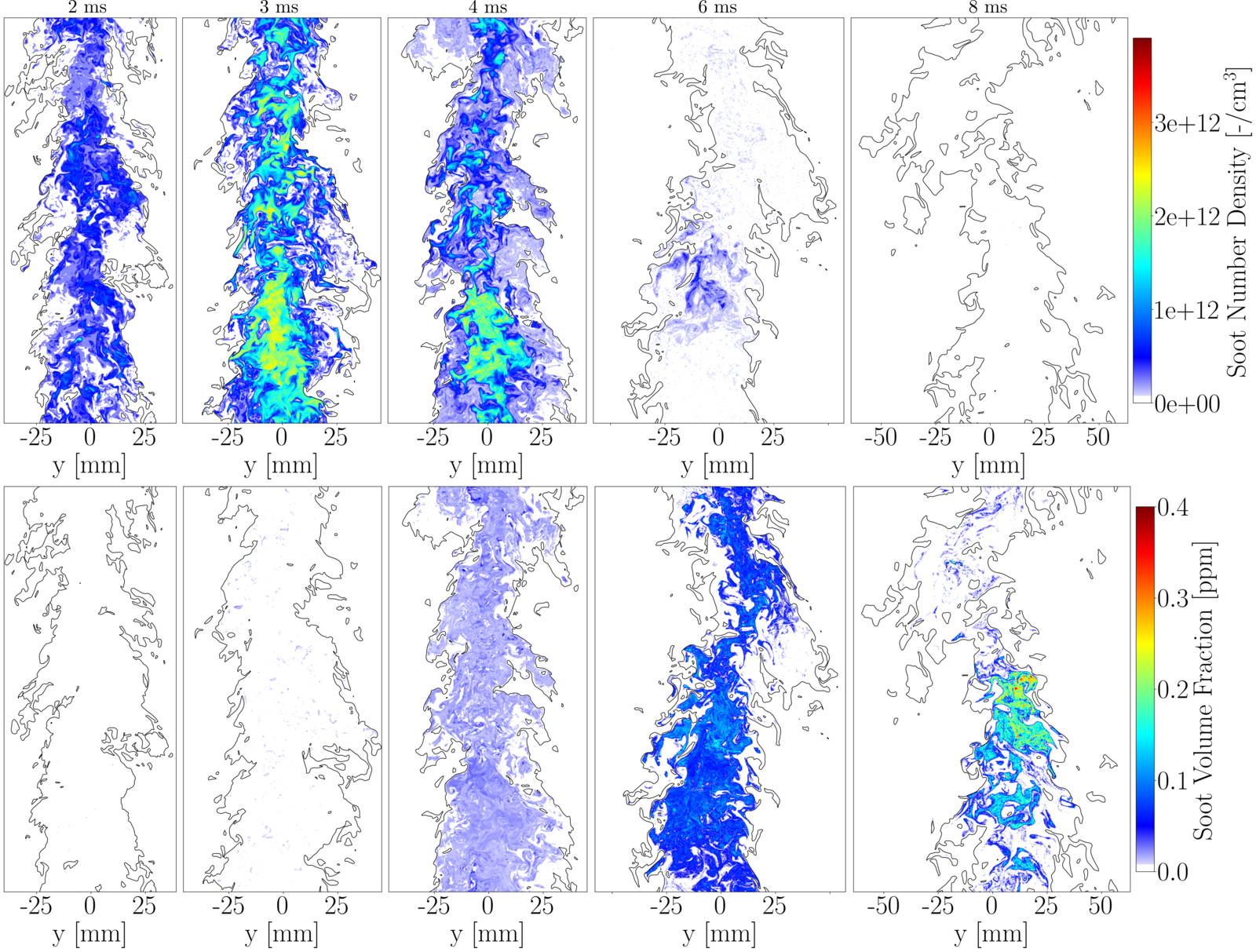ENGINEERING AND CFD
Soot Oxidation in a Turbulent Temporally Evolving Non-Premixed Air/Ethylene Jet
Principal Investigator:
Prof. Dr. Heinz Pitsch
Affiliation:
Institute for Combustion Technology, RWTH Aachen University, Aachen, Germany
Local Project ID:
SootDNS
HPC Platform used:
Hawk of HLRS
Date published:
Short abstract
A direct numerical simulation (DNS) of a turbulent air/ethylene jet was conducted to further understand soot oxidation at relevant combustion regimes. The DNS computational domain comprised 1.5 billion points, which integrated a detailed soot model and a chemical kinetic mechanism that involved 41 chemical species. Diverging from previous works primarily focused on soot formation, this project investigates the later stages of soot evolution, particularly its oxidation in turbulent flames. The roles of OH radicals and molecular oxygen in oxidizing soot particles, along with their distribution across mixture fraction space, were analyzed. Leveraging the dataset, an assessment of existing subfilter models for soot-gas phase interaction, relevant for reduced-order modeling approaches such as large-eddy simulations, suggested potential improvements for enhancing the accuracy of predicting soot emissions.

Two-dimensional slice of the DNS temperature field.
Introduction
Soot is an unwanted byproduct of practical combustion devices, such as gas turbines, and has detrimental effects on both the environment and human health as it forms and evolves. These effects are influenced not only by the overall concentration of soot but also by its chemical composition and particle number distribution. Consequently, regulations regarding soot emissions have become increasingly stringent. Advancing numerical models capable of accurately predicting soot formation, transport, and consumption, are necessary to meet these ultra-low emission targets.
Modeling of soot particle evolution poses a significant challenge due to the wide range of timescales involved, ranging from the slow formation process driven by polycyclic aromatic hydrocarbons (PAH) to the rapid consumption of particles through surface reactions. Additionally, turbulent environments typical of combustion devices introduce highly nonlinear interactions between the flow field and soot particles, requiring high-fidelity data for an accurate modelling definition.
However, obtaining experimental data for soot under turbulent conditions is challenging, making numerical simulations a valuable complement to experimental measurements in reducing the costs of cleaner combustion device development. Reduced-order models are usually employed for such development processes, although only partial information on flow dynamics is available. Moreover, state-of-the art models, also in the context of large eddy simulations (LES), often fail in accurately predict soot emissions levels, especially during the fast oxidation processes where non-linear interactions between soot and gas-phase need to be accounted for. Therefore, fully resolved simulations, i.e., direct numerical simulations (DNSs) serve as a fundamental benchmark tool for reduced-order model development, due to their high spatial and temporal resolution.
However, DNS data sets for soot formation and evolution under turbulent conditions, including detailed chemistry and soot models, are extremely sparse due to the substantial resources required to generate such data, as a detailed chemistry model is necessary to include species involved in the soot formation process. Thus, HPC systems are necessary to perform such large-scale simulations, which provide resolved data both in time and space.

Two-dimensional slices of the soot number density (top) and soot volume fraction (bottom) distribution at different time instants (2, 3, 4, 6, and 8 ms). The black line indicates the isosurface of the stoichiometric mixture fraction (Z = 0.17).
Results and Methods
In this work, a DNS of a turbulent temporally evolving non-premixed air/ethylene jet was specifically designed to observe sufficient soot formation and almost complete consumption of soot due to surface oxidation. This DNS is the first to extensively cover the later stages of soot evolution in a turbulent environment. Over 1.5 billion data points and a detailed chemical mechanism with 41 species were employed. Soot particle evolution was modeled using a statistical moment method, requiring the solution of additional equations. Due to the stiffness of the soot moment equations, a Lagrangian particle method was employed, with over 3 billion Lagrangian particles. The simulation was performed using HAWK (HLRS), utilizing up to 65,536 cores (512 nodes), totaling 40 million core hours.
The evolution of soot particles across the mixture fraction space is discussed, and implications for improved soot subfilter models are considered. Different phases of soot formation are observed (Figure 1), from the early formation phase with high number density and low soot volume fraction to the subsequent growth (increase in soot volume fraction) and final particle consumption. In the later stages of the simulation, the flame tends to close, as in the tip of a jet flame, oxidizing the remaining soot particles in the jet core. The H-abstraction/C2H2-addition (HACA) mechanism was identified as the main growth mechanism, compared to other datasets where PAH adsorption is predominant due to the richer conditions. This is attributed to the full consumption of the PAH available in the initial stages of the simulation. Almost complete soot particle consumption is achieved, with soot oxidation primarily driven by surface reactions with OH radicals, as most of the consumption occurs above stoichiometric conditions and very few particles penetrate the flame front - where O2 oxidation would become important-. This dataset is a valuable addition to the combustion community for further model development.
Finally, analyses on the filtered DNS data were conducted, including a-priori tests of existing soot subfilter models. Models that account for the interaction between soot and gas phase exhibited the best results in predicting the average soot oxidation levels of the DNS data. However, further improvements are needed for predicting the local soot oxidation layer. In the case of soot leakage events, occurring in the case of strong turbulence typical of combustion devices, an accurate prediction of the local soot oxidation layer distribution is key for better emission predictions.